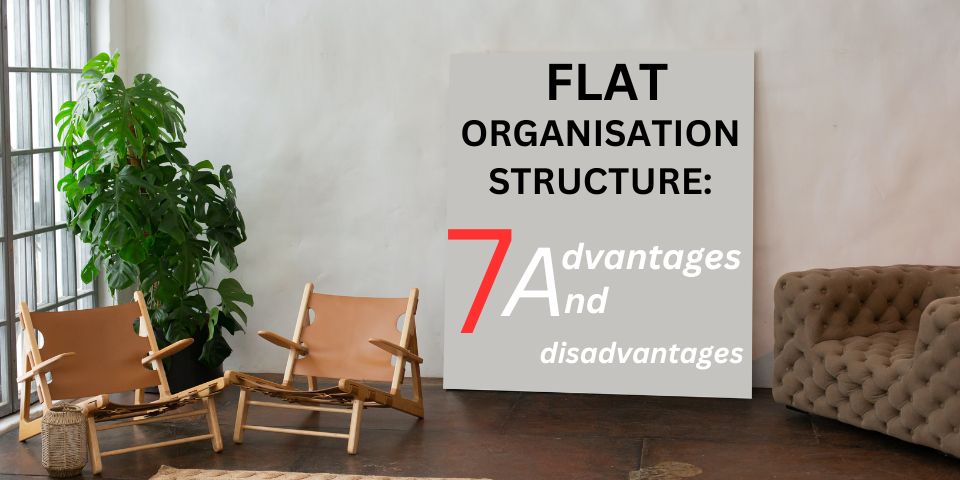7 Flat Organizational Structure Advantages and Disadvantages| Company Examples & Characteristics)
According to Study.com some billion-dollar companies like Google, Amazon, and Hubspot operate a flat organizational structure.
A bit surprised, right?
While that may be true, your amazement shouldn’t last long… once you grasp what a flat organization is and its advantages and disadvantages.
That’s what this post would do for you.
Read on!
What’s A Flat Organizational Structure?
There are a couple of organizational structures available for adoption by corporate firms. And flat organizational structure is one of them.
It’s a setup whereby there are fewer people in charge between the top people and the regular workers. In the sense that the workers have more power to make decisions and do things their way.
Often this type of organizational structure makes workers feel a sense of belonging and teamwork; rather than see themselves as a bunch of people taking orders.
Fortunately, it can get employed by different types of companies. Especially those who want to come up with new ideas and move quickly; while they focus on making their customers happy.
Characteristics of Flat Organizational Structure
Below are some of the prominent features you’ll observe in a company operating under a Flat Organizational Structure:
1. Few or no layers of management
In a flat structure of an organization, there are few levels of hierarchy. And employees have more direct access to decision-makers, unlike the Functional organization structure.
2. Decentralized decision-making
In a flat organization, the employees working on a project get to make decisions together; instead of one boss making all the decisions themselves.
3. Emphasis on collaboration
A flat organization often values collaboration and teamwork and may rely on cross-functional teams to complete projects. In other words, just like a matrix organizational structure, workers from different departments tend to collaborate and work as teams on projects.
4. Flexible job roles
Because of the flexibility in a flat organization, employees can do many different things instead of one job. In other words, they get to work on different projects and learn new things!
5. Open communication
In a flat organization, everyone talks to each other and shares what they are doing. They want everyone to know what’s happening so they can work together better. So you can say in this type of organizational structure there’s an emphasis on transparency and information-sharing.
6. Empowered employees
Since decision-making is decentralized, employees often have more autonomy and feel more empowered to take ownership of their work and contribute to the company’s success.
Advantages Of Flat Organizational Structure
1. Better and faster communication
In a company with fewer bosses telling people what to do, it becomes easier to share important information quickly. And that means that the different teams in the company can work better together and make crucial decisions fast.
So, they can also change their plans easily if something unexpected happens in the business world.
For example, let’s say you work with a large technology company with many departments, such as engineering, marketing, and sales. And in the past, your company had a very hierarchical structure, with many levels of management between the executives and the front-line employees.
And from your company’s experience that has often led to delays in decision-making and poor communication between different departments. In short, it’s the reason your company decided to flatten its organizational structure by reducing the number of management tiers to improve efficiency and collaboration.
Based on that, more than ever, information flows more quickly and easily between different teams, allowing for faster decision-making and better coordination. You’ll agree that, in turn, will help your company respond more quickly to changes in the market and stay ahead of its competitors.
Right?
So in the case of the release of a new product by your competitor, your company’s marketing team can quickly relay the information to your firm’s engineering team. And that way, your company may consider developing a similar product to stay competitive and ultimately beat the competition in your market.
And usually, a company with this type of streamlined organizational structure enhances collaboration between different departments. And that allows information to be shared more efficiently throughout a company.
2. More employee empowerment
When a company has a flat structure, it means that there are not a lot of bosses telling employees what to do. And that can be good for the employees because they get to make more decisions and take charge of their work.
So when employees feel like they have more control over their work, they can feel happier and more interested in what they are doing. Unlike workers constantly micromanaged.
3. Cost savings
Since there are not as many bosses telling people what to do in a company with a flat structure, the cost is reduced.
Yes, because the company doesn’t need to pay as many people to be in charge.
In other words, companies with flat organizational structures don’t need to hire as many people to help support the bosses. And that can help the company save money.
Disadvantages Of Flat Organizational Structure
Having looked at the pros of flat organizational structure, below are some of its cons:
1. Lack of clear hierarchy
Since there are fewer clear lines of authority, a flat structure can lead to confusion about roles and responsibilities. And that may lead to power struggles and conflicts over decision-making.
2. Overworked managers
When a company has a flat structure, bosses have to do more work and be in charge of more people. As a result, it can be hard for the bosses because they might get exhausted and feel like they can’t do as good of a job.
When people get tired and overwhelmed, they might not work as effectively as they should. In other words, they might not be able to get as much done.
3. Limited career progression
With fewer levels of management, there aren’t as many chances to move up and get a better job in the same company.
So in a company with a flat structure, even if people do a good job, they might not be able to get a higher position.
4. Lack of specialized expertise
In a flat organizational structure, employees are expected to be more versatile and take on a wider range of tasks. That means there may be fewer specialists or subject matter experts.
Unfortunately, that can result in a lack of depth in certain areas. And this, in turn, could limit the organization’s ability to develop new ideas or pursue new opportunities.
Flat Organizational Structure Example (Companies With Flat Organizational Structure)
Several companies have implemented a flat organizational structure or a variation of it. Below are examples of Companies with Flat Organizational Structures:
One such company in the USA is Valve Corporation.
Valve Corporation is a cool company that makes video games and runs a video digital distribution platform called Steam.
The way of working at Valve is called “futarchy.”
That term is adopted because people can work on whatever they want and have plenty of control, yet a small group of leaders still make the final decisions. So, it’s like a mix of being free but still having some bosses in charge!
To buttress this point with a practical scenario, let’s say Valve Corporation is working on developing a new video game.
Employees can exercise freedom as they work on different parts of the game that interest them like programming, art, or story development. In other words, they would have a lot of control over their work and be able to make decisions about how to approach their tasks.
But, when it comes to making big decisions about the game, like what features to include or how to price it, a small group of leaders would take charge. And often, these leaders would gather input from everyone on the team, but ultimately, they would be responsible for making the final call.
Other examples of Companies with flat organizational structures in the USA include Zappos, GitHub, W.L. Gore & Associates, Morning Star, etc.
Companies with flat organizational structures in Nigeria
There are a good number of companies operating under a flat organizational structure in Nigeria. And of them is PayStack.
As a Nigerian company in the fintech industry, PayStack helps other businesses to get paid online. In her flat structure, people work together in a way that’s like everyone is on the same level.
At Paystack, they like to work together and share their ideas. Simply put, workers listen to each other and make good and sound decisions for the company.
To drive home that point, here’s a practical example that illustrates how PayStack’s flat organizational structure might work in practice:
Let’s say that Paystack is working on improving its online payment platform.
You’ll agree that employees from different departments would collaborate. So that they can identify areas where they can improve the platform.
For example, the customer service team might suggest adding a new feature. Yes, one that would make it easier for customers to get help when they have questions.
Instead of going through a long chain of command to propose the idea, the customer service team can share her idea directly with the relevant team.
In other words, they could work together to refine the idea and find the best way to execute it. And often, this process of collaboration and transparency ensures that the best ideas can rise to the top. Regardless of where they come from within the company.
In the end, this type of organization fosters a culture of creativity and innovation. In the case of Paystack, everyone is motivated to share ideas, even as they work in team spirit to better the company.
Meanwhile, other companies with flat organizational structures in Nigeria include Konga, Flutterwave, Andela, Farmcrowdy, etc.
Final Thoughts
Some people believe that a flat structure can be good for some types of companies, like new ones or small ones. Especially those who need to be able to move fast and change their plans easily.
While others think that, for bigger or more complicated companies that need people with special skills to do specific jobs, a flat structure might not work as well.
But when picking a perfect organizational structure for a company, you must thoroughly consider your business needs and goals.




![Practical Ways to get rid of Lazy Workers at Workplace [Explained]](https://greatcrackers.com/wp-content/uploads/2022/03/dealing-with-lazy-workers.jpg)



